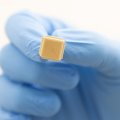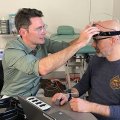IMB researchers took out two of the four awards on offer at the recent Queensland Health and Medical Research Awards.
Dr Richard Clark won Senior Researcher of the Year for his work on developing a medication for chronic pain using cone snail venom, while Dr Kate Schroder was named Postdoctoral Researcher of the Year for completing the first comparison of mice and human innate immune systems.
Chronic pain affects one in ten people at some stage in their life and is very difficult to treat, particularly neuropathic pain, which occurs when the nervous system itself is damaged.
"Many drugs currently on the market for treating neuropathic and chronic pain can have serious side effects, and only work in about a third of patients. The need for new therapies is clear," Dr Clark said.
Molecules from cone snail venom are very effective in treating chronic pain, however, they are
unsuitable for use as drugs because they degrade in the body and don't reach their target.
Dr Clark is investigating a way to stabilise the cone snail molecules by combining them with other molecules that don't degrade and don't have any effect on the body.
"By combining these molecules, we have engineered one that is targeted, stable and effective," Dr Clark said.
He is now applying for funding to further test the molecule and determine if it is safe for use in humans.
Dr Schroder won her award for work studying the innate immune system, which provides general protection against infection from invading organisms. The innate immune system co-evolves with the pathogens it faces as each tries to get the upper hand.
Innate immunology, like many scientific fields, uses the mouse as a model system for investigating how the immune systems functions.
What this means for immunologists is that the mouse and human innate immune systems could have evolved in quite separate ways, as each species battles its own set of pathogens and infectious diseases.
Dr Schroder found the active genes in the mouse and human innate immune systems differ by about 20 percent. This information, and the exact genes which differ, will be useful for immunologists using mice as a model for human diseases.
Dr Schroder has since left the IMB and now works in Professor Jurg Tschopp's laboratory at the University of Lausanne in Switzerland, one of the premier innate immunology laboratories in the world.
Media: Bronwyn Adams (07 3346 2134, b.adams@imb.uq.edu.au)
.jpg)









